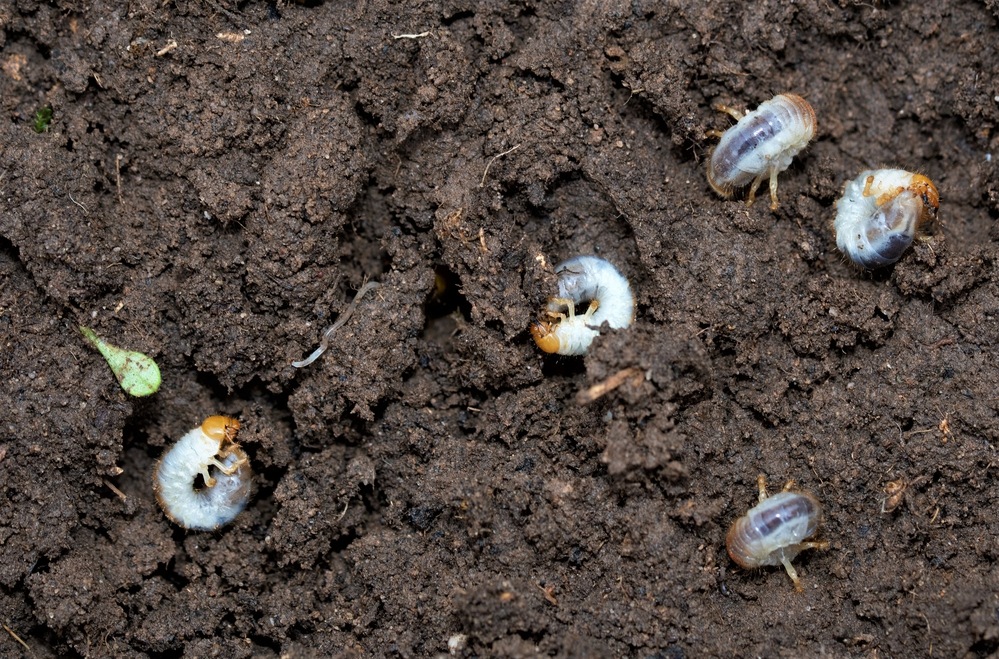Have you noticed dead or dying plants in your garden? Maybe you’ve started to see more pests than normal in your lawn.
If so, it’s time to protect your space with an option like beneficial nematodes.
Here at Pest Dude, we have more than 20 years of experience in the pest management field, and we’re sharing everything you need to know about beneficial nematodes and how to use them on your property.
Key Takeaways
- Beneficial nematodes are microscopic, parasitic worms used to control soil-dwelling pests like grubs, beetles, and caterpillars.
- To use beneficial nematodes correctly, identify your target pests, purchase live nematodes (this is very important), make sure the conditions are suitable for application, water the area before and after application, use the correct application method, store the nematodes properly, monitor the effectiveness of the treatment and reapply if needed, and combine this tactic with other pest management practices.
- For more help getting rid of insects, beetles, and more, contact us to connect with a professional pest management company in your area – (844) 532-0076.
What are Beneficial Nematodes?
Beneficial nematodes are tiny, worm-like creatures that live in the soil.
Unlike other nematodes, which harm plants, beneficial nematodes help control lawn and garden pests like grubs, caterpillars, and garden beetles.
They work by getting inside the pests and releasing bacteria that kills them – without harming plants or non-target species.
When used correctly, beneficial nematodes can reduce pest populations without introducing harmful chemicals to your space, so they’re great for anyone who wants to take an eco-friendly approach to lawn and garden care.
Are Beneficial Nematodes Effective Against Pests?

Yes – beneficial nematodes are an effective eco-friendly pest management option.
That said, they only work if you buy live nematodes and apply them properly under the right environmental conditions.
Pros of using beneficial nematodes:
- Green and Eco-Friendly: Unlike chemical pesticides, beneficial nematodes pose no threat to humans, pets, or non-target species.
- Targeted Pest Control: These nematodes specifically seek out and kill soil-dwelling pests, and they do it without harming beneficial insects like bees and ladybugs. This specificity helps maintain biodiversity and balance in your lawn or garden.
- Residual Effect: Beneficial nematodes continue to work long after application. This means they provide longer-lasting pest protection than many chemical treatments, which break down quickly.
Cons of using beneficial nematodes:
- Sensitive to Environmental Conditions: Beneficial nematodes require specific conditions to be effective. They are sensitive to ultraviolet light (UV) and extreme temperatures, which can limit their viability.
- Proper Application is Crucial: For nematodes to be effective, they must be applied correctly in terms of timing, method, and conditions. Incorrect applications can render them ineffective, wasting time and resources.
- May Require Reapplication: Depending on the extent of the pest problem and environmental factors, you may need to make several beneficial nematode applications to achieve your desired level of control. This can increase the cost and labor associated with using nematodes for pest management.
While beneficial nematodes can be a highly effective means of controlling specific garden pests, their success largely depends on proper application and timing.
As long as you use them properly, they’ll help keep your garden safe without introducing harsh chemicals into your outdoor space.
How to Apply Beneficial Nematodes
To use beneficial nematodes to control pests, follow these steps:
1. Identify Target Pests
First, you’ll need to identify the pests that are wreaking havoc on your space.
Beneficial nematodes are effective against many soil-dwelling insects, including Japanese beetles, grubs, fleas, and more.
To get rid of pests as quickly as possible, make sure you know what kind of pests you’re dealing with and that you’re buying nematodes that will target them.
2. Purchase Live Nematodes
Here’s the biggest caveat about using beneficial nematodes as a pest control method: you must buy the right kind.
Do-it-yourself home stores and sites like Amazon often sell nematodes that arrive dehydrated.
While the packages promise that the nematodes will become active as soon as you add water, we seriously doubt it.
When we use nematodes in the industry, we buy them live and on ice, and homeowners should do the same. For best results, invest in a product like this.
3. Make Sure the Conditions Are Right
Beneficial nematodes thrive in moist, not waterlogged, soil – we’ll discuss how to moisten and prepare the soil in the next step.
Before applying the nematodes, make sure the temperature is ideal – it should be between about 57°F-91°F for optimal nematode activity.
Additionally, we recommend paying attention to UV levels. Since harsh sunlight can harm nematodes, apply them late in the day or under overcast conditions.
Applying them at the right time ensures the nematodes can be as active and effective as possible.
4. Water the Area Before and After Application
Before you apply the nematodes, water the soil to make sure it’s not too dry.
After application, moisten the area again to allow the nematodes to penetrate the soil easily.
5. Use the Correct Application Method
Now, it’s time to apply the nematodes.
For best results, make sure you’re following all application instructions carefully – including abiding by species-specific application instructions.
The live nematodes we mentioned earlier in this blog can be applied with a watering can, irrigation system, knapsack system, or motorized sprayer.
6. Store the Nematodes Properly
If you’re not applying the nematodes immediately after purchase, store them as advised, typically in a refrigerator, to maintain their viability.
7. Monitor Effectiveness After Application
After application, monitor the pest population in the treated area.
While you’ll usually see results in about 1-2 weeks, you may need to complete another application (or invest in other pest control methods) if your bug problems persist.
8. Combine with Other Pest Management Practices
For comprehensive pest management, use nematodes in conjunction with other pest management practices like insecticides, fungicides, and herbicides.
If your pest problem is severe, consider hiring a professional pest management company for assistance.
Are you Looking for a Pest Management Professional in Your Area? We can Help!
While beneficial nematodes can be an excellent DIY pest control method, sometimes you need more help.
Luckily, we’re here for you!
We work with a vast network of highly qualified pest management professionals.
Contact us at (844) 532-0076, and we’ll connect you with a reliable local team.

Get a Free Quote
Give us a call today to receive your free, no-obligation pest control quote.
Beneficial Nematodes FAQs
Beneficial nematodes begin their work shortly after application, attacking their target pests within 48 hours, and visible pest control results usually show up about 1 to 2 weeks after treatment.
How quickly you’ll see changes depends on the kind of pest, how many there are, the weather, and how you apply the treatment.
For big infestations, it might take longer to see the full effect.
Keep an eye on things and consider a second treatment if needed, following the guidelines for the specific nematode species you’re using.
To see if beneficial nematodes are working, monitor your pest levels. If there are fewer pests a few weeks after you use them, it’s a good sign that the nematodes are doing what they should.
The nematodes are probably working if plants look healthier and there’s less damage in your garden.
You can also look at the soil under a microscope to see nematodes attacking pest larvae.
Remember, the weather and how you apply them can affect how well they work. Make sure to follow the instructions and keep an eye on your plants to get the best results.
Beneficial nematodes are considered safe for humans, pets, and the environment.
They are targeted biological control agents, specifically searching for and attacking pests like grubs and soil-dwelling larvae.
These nematodes do not pose any known risk to human health as they cannot survive in the human body or on human skin.
This means that using beneficial nematodes as a part of your pest management strategy is effective and safe and will have no negative impact on human health and non-target species.






